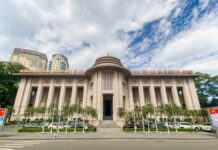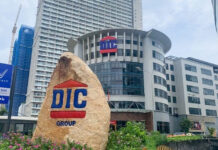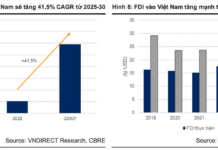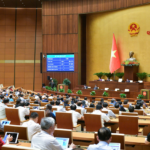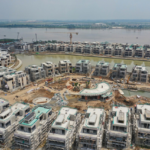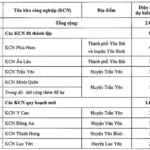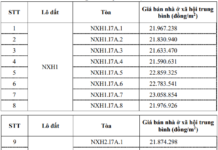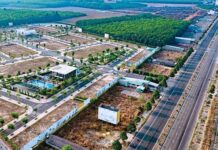The “Shirt” is Too Big for Its Own Good
In 1994, Nhon Trach district in Dong Nai province was established, with a total area of 431 sq. km. Two years later, the master plan for the new Nhon Trach urban area was approved, spanning thousands of hectares with a vision to become a type-II city in Dong Nai province and a satellite city of Ho Chi Minh City.
A decade later, in 2006, the Prime Minister approved adjustments to the plan, designating Nhon Trach as one of the key centers for industry, trade, services, tourism, education, training, and science and technology in Dong Nai province.
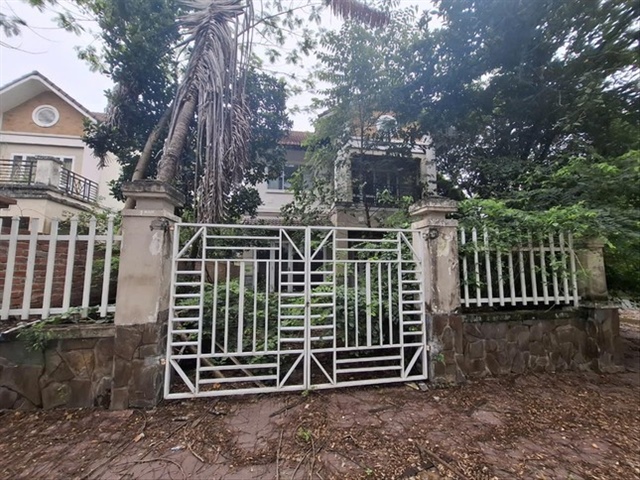
Completed villas lie vacant and empty. |
Strategically located just 30 km from Ho Chi Minh City’s center and nestled within the economic triangle of Ho Chi Minh City, Dong Nai, and Ba Ria-Vung Tau, Nhon Trach became a hotbed for urban development projects, with hundreds of real estate ventures vying for a piece of the action. To facilitate the planning and development of the new urban area, 74 large-scale projects spanning nearly 5,000 hectares of land were allocated to investors.
The race to build began in earnest in 2003, but over the next two decades, only 12 projects were partially completed before grinding to a halt. The rest were left abandoned or with investors cutting their losses and running. Nhon Trach earned a reputation among real estate insiders as a “ghost town” or the “big con of the decade.”
A prime example of this is the Long Tho – Phuoc An urban area, developed by the Housing and Urban Development Corporation (HUD) with an area of 223 hectares. This area boasts a comprehensive range of infrastructure, including roads, water supply and drainage systems, electricity, telecommunications, greenery, fire protection, and a water treatment plant…
Additionally, the project offers a host of amenities such as schools, kindergartens, a cultural center, sports facilities, a medical clinic, a commercial center, a post office, banks, and parks. However, despite all these features, dozens of villas and terraced houses worth billions of dong lie vacant, their glass doors and walls damaged, and nature slowly reclaiming the area.
Venturing inside the partially constructed villas in Long Tho – Phuoc An is not for the faint of heart. Over the years, these once-promising homes have fallen into disrepair, with crumbling bricks, termite infestations, and other signs of neglect.
Similarly, the Thang Long Home – Phuoc An residential area, developed by Thang Long Real Estate Joint Stock Company, is considered the first commercial housing project in Nhon Trach. Launched in November 2015, the majority of the approximately 400 houses here remain unoccupied, with many “for sale” signs on display.
According to a resident, most buyers of properties in Thang Long Home – Phuoc An were caught up in the land fever surrounding Nhon Trach. However, upon moving in, they were dismayed to find a lack of essential amenities and a sparse population.
Along Thich Quang Duc Street in Phu Hoi commune, the Cat Tuong Hung Phat integrated high-rise project presents a picture of decay, with completed villas left to the elements and others still at the foundation stage. Of the 5-hectare project, only a handful of villas have been constructed to the finishing stage, while the rest lie abandoned, overgrown with vegetation.
Ms. Hoang Thi Yen, a resident of the Dầu Khí Power Company apartment complex, shared her experience of living in the area. She explained that the entire new Nhon Trach urban area is isolated and far from the district center, lacking essential services such as hospitals, markets, and restaurants, which makes daily life inconvenient. Ms. Yen’s family lives there because her company provided the accommodation, but her children have to be driven over 5 km to school every day.
Five Land Frenzy Episodes
Looking back, it is evident that the new Nhon Trach urban area has been plagued by five episodes of land fever fueled by exaggerated claims about infrastructure projects. As a result, real estate investors have largely lost faith in the area.
The first land fever occurred in 1996 when Nhon Trach was approved for development into a city with a projected population of 500,000 by 2020 and an area of 8,000 hectares.
The second episode began in 2006, with news of a bridge connecting to Ho Chi Minh City’s District 9 (formerly). In 2014, the third wave hit after the Long Thanh International Airport project was given the green light.
The fourth wave came in 2016 when Ho Chi Minh City proposed to the Prime Minister to approve the construction of a bridge to replace the Cat Lai ferry. The fifth and final wave occurred in August 2018 when the People’s Committee of Dong Nai province met with Ho Chi Minh City authorities regarding the construction of the Cat Lai bridge. Dong Nai expressed impatience with Ho Chi Minh City’s slow progress on the necessary procedures and proposed taking over the project themselves.
Mr. Nguyen Van Long, owner of a real estate business, shared his experience: “Amid the frenzied buying and selling of real estate in 2020, I also purchased a villa in the Long Tho – Phuoc An urban area, which I later sold. At one point, land prices here soared to 7-8 million dong per square meter, and hundreds of real estate companies were actively operating. A single plot of land could be bought and sold within the same day by investors. Many of the abandoned villas and land plots here already have owners, but they live in Hanoi or Ho Chi Minh City. These owners often have to rely on brokers to locate their properties on a map because they are unfamiliar with the area.”
According to the Nhon Trach Urban Management Department, there are currently around 200 large and small projects in the district, nearly half of which are planned as modern residential areas. The government has constructed roads and provided electricity connections to these projects.
However, compared to the initial plans, the number of projects currently under construction is very low. Even if they are completed, people may not move in due to the lack of social infrastructure to support a comfortable lifestyle.
Mr. Nguyen The Phong, Chairman of the People’s Committee of Nhon Trach district, shared that in 2023, the district proposed to the province of Dong Nai to revoke about 20 expired projects. Regarding the abandoned housing projects, Mr. Phong stated that since these projects have legal status, the district is focusing on developing social infrastructure, such as schools and markets, to serve the residents.
“The district of Nhon Trach has also requested that investors complete the housing projects and is working with companies that have the capacity to support their development. For companies that do not meet the requirements, the district will propose revoking the projects in accordance with regulations,” Mr. Phong added.
|
Mr. Le Hoang Chau, Chairman of the Ho Chi Minh City Real Estate Association (HoREA), opined that most of the land in the Nhon Trach projects is currently in the hands of speculators, and the constant rumors have made it challenging to establish a stable community. He suggested that building a bridge connecting Ho Chi Minh City to Nhon Trach would go a long way toward solving this issue. However, it is important to note that it was these very bridge-building rumors that have, in the past, caused turmoil in the area due to speculation. Therefore, the key lies in making concrete plans and setting a clear timeline for completion, rather than merely announcing intentions or spreading rumors, to stimulate genuine demand from buyers. |
MANH THANG-DUY QUANG
The Housing Act: Governing the Real Estate Market and Social Housing Development
On November 23rd, as part of the 8th Session of the National Assembly, a resolution was passed to “Continue enhancing the effectiveness of policies and laws related to the management of the real estate market and the development of social housing.” This session was presided over by Vice Chairman of the National Assembly, Nguyen Duc Hai.
High-Speed North-South Rail: Unleashing the Power of Vietnamese Contractors
The domestic transportation businesses are gearing up to take on the ‘mammoth’ task of the high-speed North-South railway project. By utilizing domestic contractors, we can harness our internal strengths and reduce our reliance on foreign entities.









